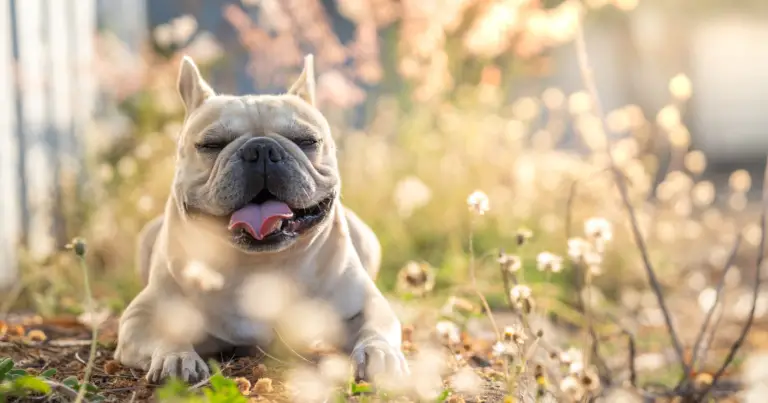French Bulldog Crate Training Guide

If you’re a proud French Bulldog owner, you know that training is essential for a happy and well-behaved canine companion. One indispensable aspect of that training is crate training. This guide aims to provide you with the necessary steps, tips, and tricks to ensure a smooth and effective crate training experience for both you and your French Bulldog.
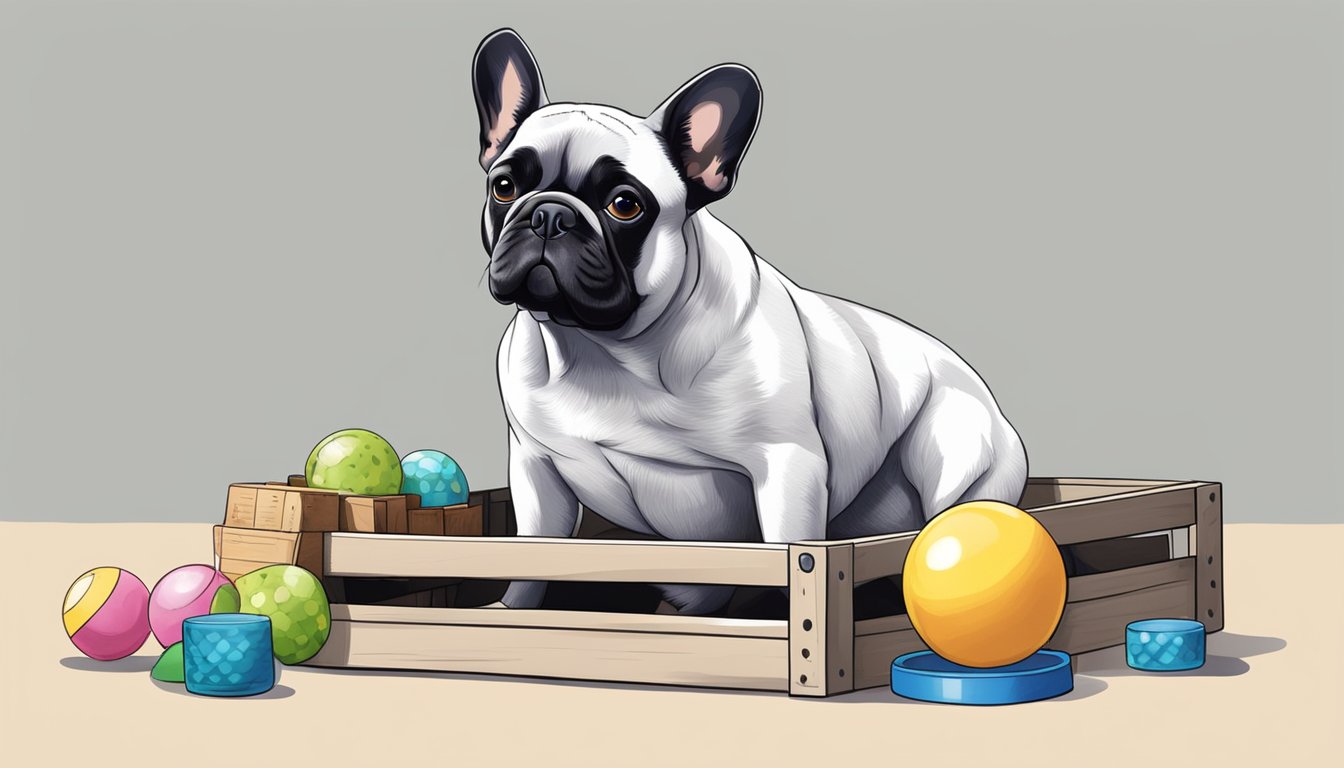
Understanding your French Bulldog’s unique temperament and needs is crucial to developing an effective crate training plan. This breed, known for their lovable and sociable nature, thrives in a comfortable and secure environment when crate training.
The process may seem daunting, but don’t worry. This French Bulldog crate training guide will walk you through essentials such as choosing the right crate, preparing it for your Frenchie, and determining the appropriate training session duration and frequency to make the journey a positive experience for you both.
Contents
Key Takeaways
- Establish a safe and comfortable environment to effectively crate train your French Bulldog.
- Tailor training sessions to your Frenchie’s unique temperament and needs, ensuring proper duration and frequency.
- Utilize crate training to address separation anxiety, ease travel, and transition to a larger living space.
Table of Contents
Understanding Your French Bulldog
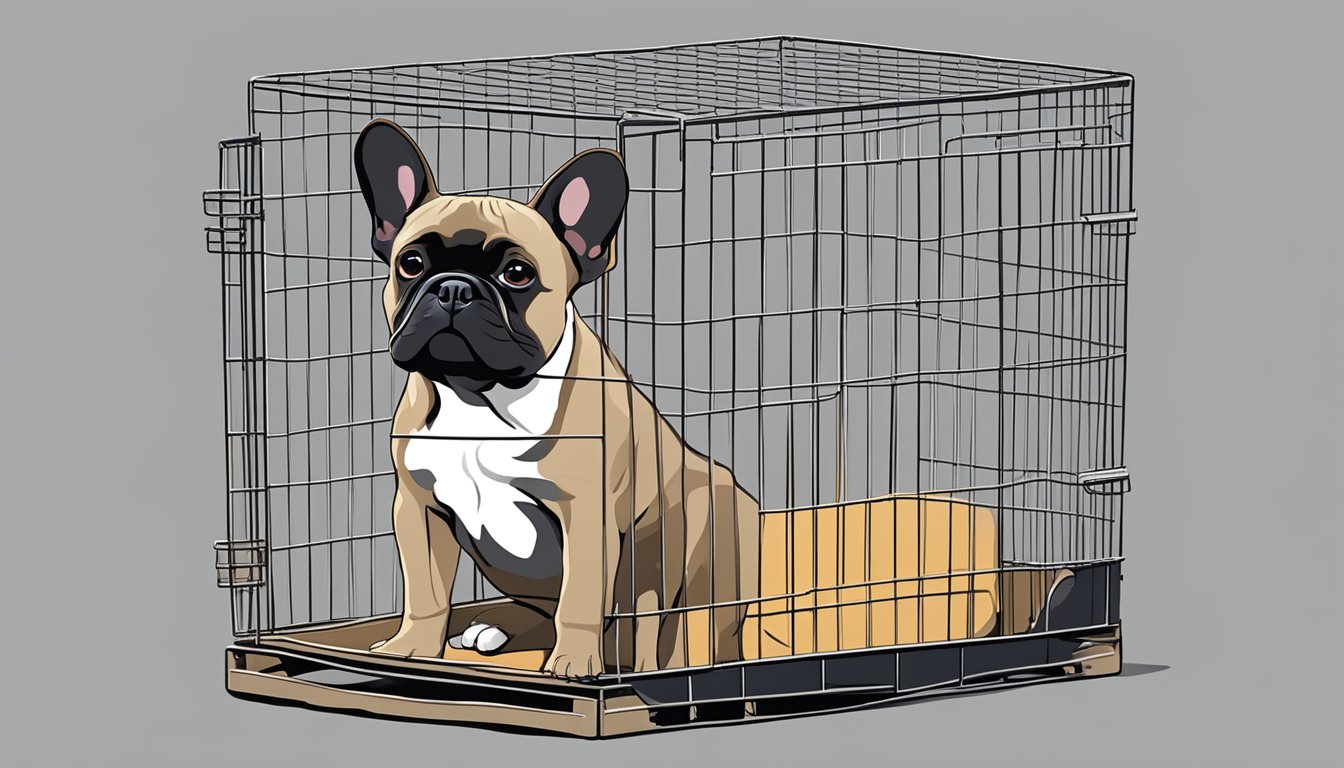
When you bring a French Bulldog into your home, it’s essential to understand their breed characteristics and personality traits. This will help you develop a better bond with your Frenchie and make the crate training process smoother.
French Bulldogs, affectionately known as “Frenchies,” are a small breed, typically weighing anywhere from 16 to 28 pounds. They have a stocky build, large bat-like ears, and a smushed face that gives them a unique appearance.
One of the most lovable traits of a French Bulldog is their friendly and sociable personality. They’re great with children, other pets, and even strangers. Their playful nature and eagerness to be around people make them great companions in any home.
However, part of understanding your Frenchie is also acknowledging their potential health issues. Due to their facial structure, they may experience breathing difficulties, especially in hot weather or intense physical activity. It’s important to keep their exercise routines moderate and provide a cool, comfortable environment for them to rest in.
Grooming is relatively simple with French Bulldogs. They have short coats and minimal shedding, making their grooming needs infrequent. A regular brushing, occasional bath, and maintaining their nails and ears should be sufficient to keep your Frenchie looking and feeling their best.
Now that you have a better understanding of your French Bulldog’s breed characteristics, personality, and health, you can better prepare yourself for their crate training journey. Remember that patience, consistency, and positive reinforcement are key factors in making this process successful. So cherish the time spent with your Frenchie and enjoy the bonding experience that crate training offers.
Essentials of Crate Training
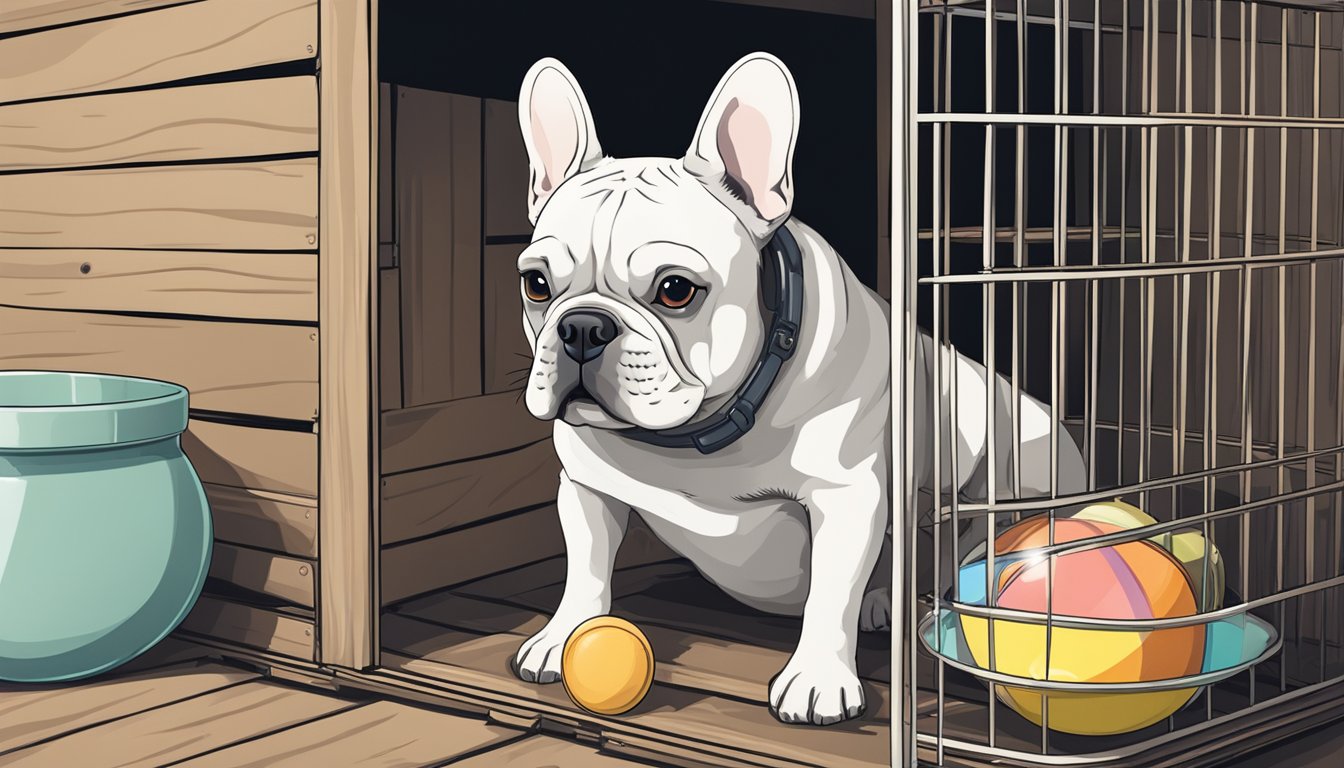
So, you’ve decided to crate train your French Bulldog? Great choice! Crate training offers a safe and cozy space for your furry friend. Let’s dive into the essentials of crate training, making the process enjoyable for both you and your pup.
First, choose the right crate. Consider one that’s large enough for your French Bulldog to stand up, turn around, and lay down comfortably. Remember, it shouldn’t be too big, as it will encourage them to potty in one corner and sleep in another.
Now that you have the ideal crate, it’s time to establish a routine. Start crate training as early as possible, preferably when your pup is young. Introduce the crate gradually, allowing your pup to explore and get comfortable with it. You can use treats or toys to make the crate more inviting.
Consistency is key in crate training. Have designated times for your pup to be in the crate, such as during meal times or when you’re away from home. This helps you create a schedule that your dog can easily follow.
As you progress with crate training, be patient and consistent. French Bulldogs are known to be stubborn at times, so it’s important to remain calm and supportive during the training process. Keep in mind, each dog’s learning pace is different, but with time, they will get the hang of it.
To help your pup adjust, start by leaving them in the crate for short periods. Gradually increase the duration as they become more comfortable. It’s crucial to monitor your dog’s reactions and adjust the timings accordingly. Remember, crate training should always be a positive experience!
Finally, remember that crate training is not a form of punishment. Instead, it’s a safe environment for your dog to rest and relax in. Encourage their love for the crate by offering rewards, praising, and giving them plenty of love when they enter or exit the space willingly.
By following these essentials of crate training, you’ll create a loving relationship with your French Bulldog, ensuring their safety and comfort throughout their life. Happy crate training!
Crate Train French Bulldog: Watch this
Choosing the Right Crate
When it comes to crate training your French Bulldog, one of the first steps is to choose the right crate. Finding the perfect size and type of crate is essential for your Frenchie’s comfort and training success.
The crate you choose should be big enough for your pup to stand up, turn around, and lay down comfortably, but not so big that they have room to go potty in one corner and sleep in another. A good rule of thumb is to choose a crate that is just large enough to comfortably accommodate your French Bulldog in their natural standing and lying positions.
When considering the type of crate, a wire crate is often a popular choice among French Bulldog owners. Wire crates provide good ventilation, are easy to clean, and can be easily folded for transportation. Plus, they usually come with a divider, allowing you to adjust the crate size as your Frenchie grows.
It’s essential to pick a crate made from durable material to withstand your French Bulldog’s natural curiosity and potential chewing tendencies. A quality crate will also provide added safety during transportation.
Remember to create a welcoming environment inside the crate, furnishing it with a comfortable bed, toys, and water. This not only ensures your dog’s comfort but will also encourage them to view the crate as their safe space.
In conclusion, by carefully considering the size, construction, and material of the crate, you will create an optimal environment for your French Bulldog’s crate training journey. Remember that a comfortable and well-fitted crate is essential in ensuring a happy and successful crate training experience.
Preparing the Crate for Your Frenchie
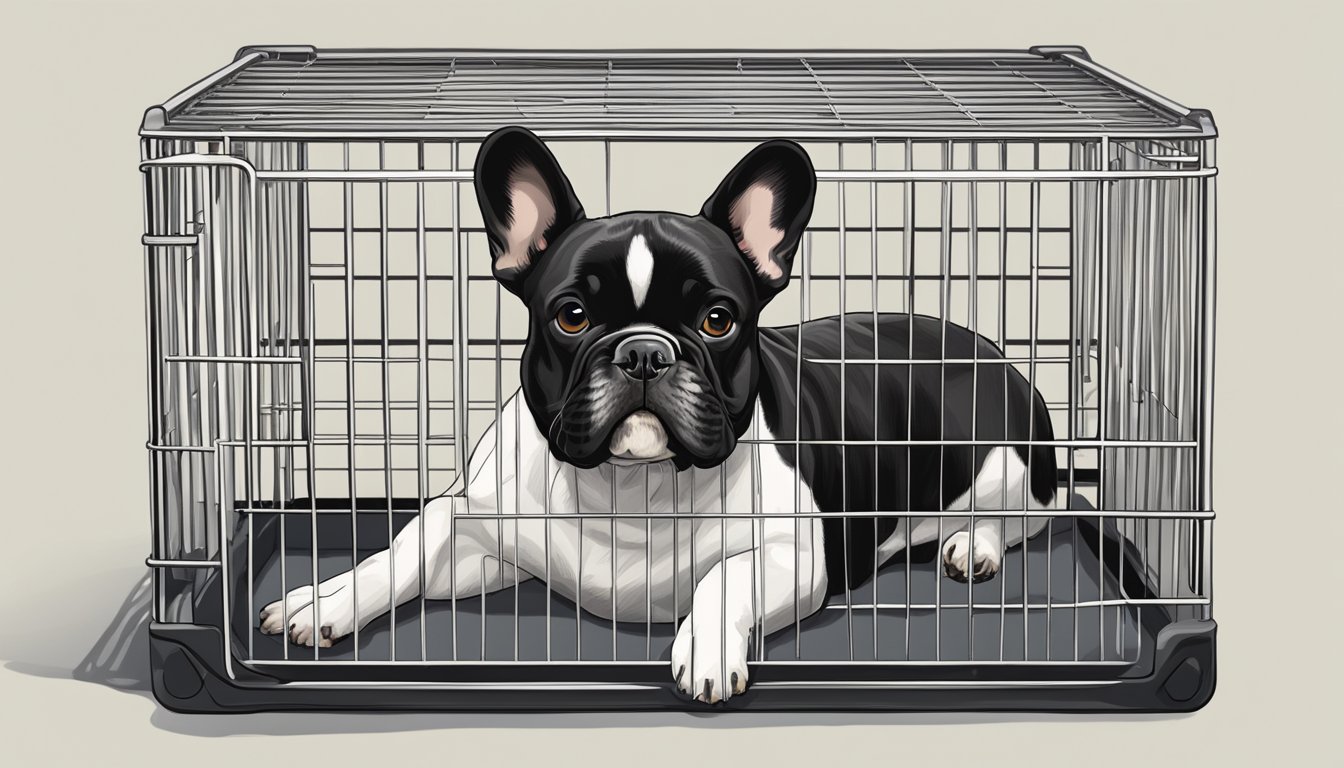
Are you ready to create a positive experience for your French Bulldog during crate training? Great! Let’s start by setting up a secure and comfortable crate for your Frenchie.
First things first, choose a crate that’s the right size for your French Bulldog. Make sure your buddy can stand upright, sit down without their ears touching the roof, as well as turn around easily and stretch out comfortably while lying down. A properly sized crate is essential to avoid any discomfort or inconvenience during the training process.
Now, it’s time to make the crate more cozy and inviting for your Frenchie. Add a soft, machine-washable bed or blanket for cushioning and warmth. This will make the crate feel like a safe, comfortable space your dog will be drawn to.
To provide your Frenchie with mental stimulation and a sense of familiarity, place some toys and their favorite chew items inside the crate. This not only makes the crate a fun place to be, but also helps prevent boredom and destructive behavior when they’re in the crate.
Treats and toys are essential elements to make the crate training a positive experience. When introducing your Frenchie to the crate, use treats to encourage their curiosity. Place one or two treats near the entrance of the crate and gradually move them further inside. Your dog will be motivated to explore the crate and associate it with positive rewards.
In addition, remember to keep the crate door open during the initial introduction phase so that your Frenchie can enter and exit the crate at their own pace. Allowing them to feel secure and in control is essential to building a positive crate training experience.
By preparing the crate properly and considering your French Bulldog’s comfort, you’ll be well on your way to a successful crate training journey. So go ahead, make your Frenchie’s crate a haven they’ll love to call their own!
Training Sessions: Duration and Frequency
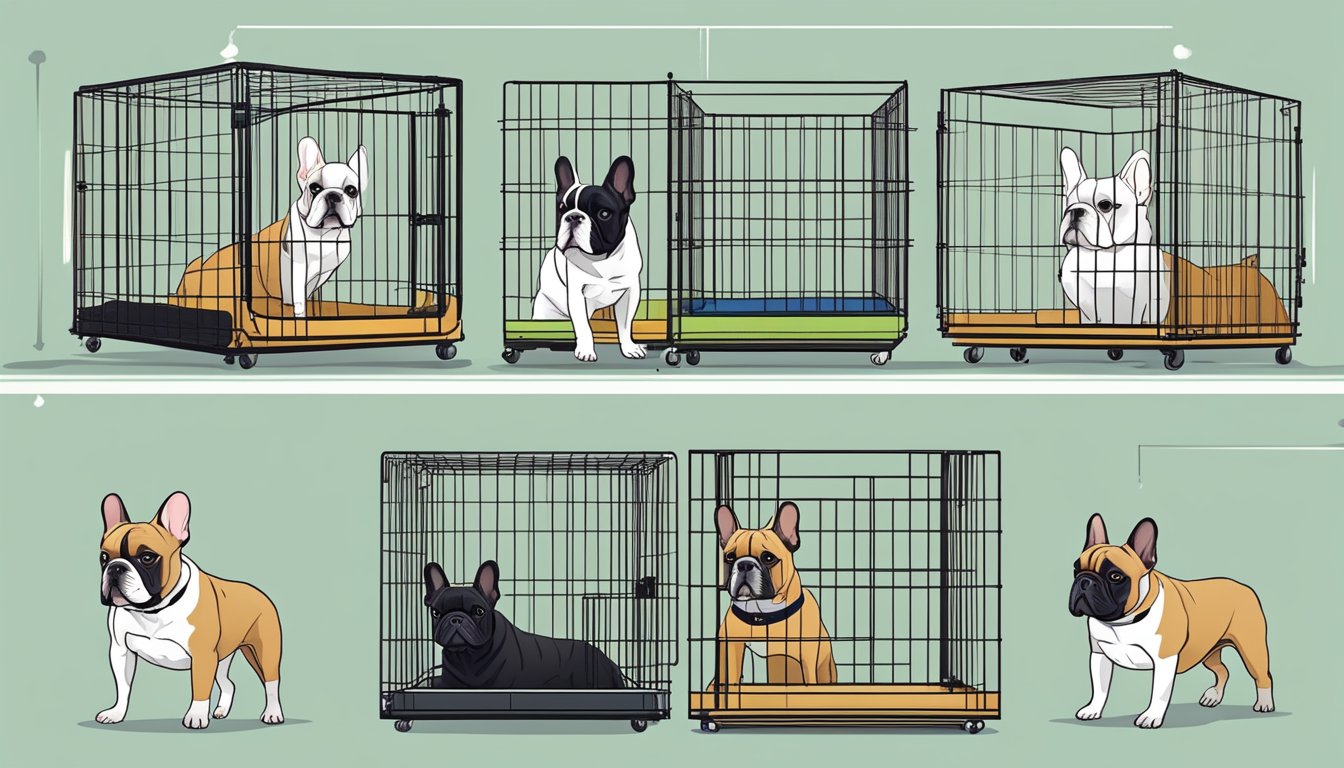
When it comes to crate training your French Bulldog, it’s crucial to establish a routine that works for both you and your pup. Remember, consistency is key. So, how long should each training session last, and how often should they occur?
Short periods of time are ideal for training sessions, especially in the beginning. Aim for about 10-15 minutes per session, as this will help prevent your Frenchie from becoming overwhelmed or bored. Gradually increase the duration as your pup becomes more comfortable and confident in their new crate.
In the initial stages of crate training, you should aim to conduct sessions at least twice a day. This frequency helps your French Bulldog associate the crate with positive experiences, speeding up the learning process. As your dog becomes more accustomed to their crate, you can reduce the number of sessions.
It’s essential to use positive reinforcement during the training process. Praise your Frenchie whenever they behave well in the crate. Offer them treats, toys, or affection to help them associate the crate with good things. Be patient; every dog learns at their own pace.
Remember, adopting a friendly and conversational tone in your training sessions will make it more enjoyable for both you and your French Bulldog. Keep the atmosphere light-hearted and fun. Let your Frenchie explore their new crate at their own pace, and never force them inside if they seem reluctant or scared.
In summary, establishing a routine with short training sessions at least twice a day and gradually increasing the duration as your pup progresses will make crate training a success. Be sure to use positive reinforcement, be patient, and maintain a friendly and engaging tone throughout the process. With time and consistency, your French Bulldog will be comfortable and happy in their new crate.
Addressing Separation Anxiety
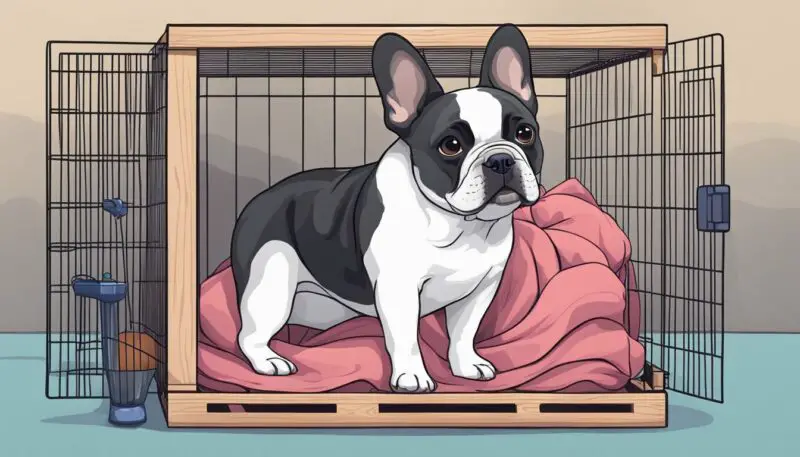
Dealing with separation anxiety in your French Bulldog can be a challenging experience. The good news is that crate training can play a significant role in addressing this issue. By providing a safe and secure space for your dog, you can help reduce anxiety-related destructive behaviors and promote overall well-being.
One of the common symptoms of separation anxiety in French Bulldogs is urinating and defecating when left alone, even if they are fully potty-trained. If you notice this behavior, incorporating crate training can be a useful technique for managing these behavioral problems.
To help them feel comfortable in their crate, consider adding their favorite toys and a soft blanket to create a cozy environment. Gradually increase the time your dog spends in their crate, always making sure to reward them for staying calm and relaxed.
Crate training can also help with other anxiety-related behaviors like chewing and digging, by providing a designated space for your French Bulldog to feel secure. By consistently using the crate, it becomes their safe haven and helps reduce the chances of destructive behavior when left alone.
Remember to balance crate time with quality bonding time, exercise, and socialization. This combination will help build your dog’s confidence, maintain good behavior, and minimize separation anxiety.
Keep in mind that patience and consistency are key when working on addressing separation anxiety and crate training. It may take time for your dog to adapt, but with perseverance and a friendly approach, you and your French Bulldog will face this challenge together.
Benefits of Crate Training for Travel
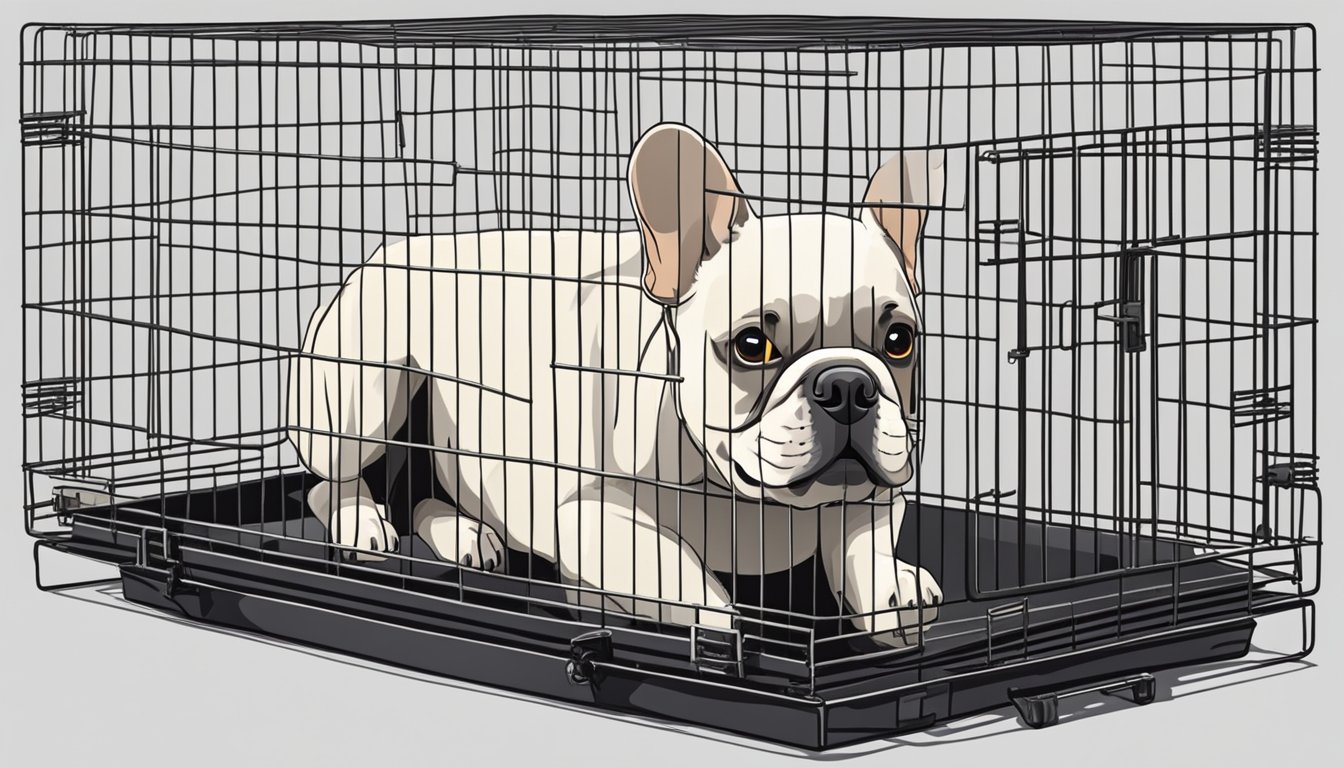
When it comes to traveling with your adorable French Bulldog, crate training can be a lifesaver! Let’s dive into the perks of crate training for travel and transportation.
First of all, crate training ensures your Frenchie’s safety during travel. A well-trained dog in a travel crate will feel comfortable, reducing anxiety and stress in transportation situations like car rides and airplane journeys. Plus, it’ll help keep them secure in the event of any sudden movements or accidents.
Crate training also makes your French Bulldog easier to manage in new environments. Bringing along their crate means they’ll have a familiar, safe space to retreat to when faced with unfamiliar surroundings. This can be particularly helpful in keeping your furry friend calm and happy during overnight stays at hotels or when visiting friends and families.
Another great reason to consider crate training is that it helps with keeping your French Bulldog well-behaved in transit. A crate-trained dog is less likely to engage in destructive behaviors and will understand that being in the crate means they should relax and stay calm. This makes trips much more pleasant for both you and your lovable companion.
Traveling with an untrained dog can sometimes hinder social interactions with other dogs and people. However, if your French Bulldog is crate trained, they’ll feel more confident and secure during these interactions. Having a crate as their personal sanctuary allows them to warm up to the new environment at their own pace, promoting positive social experiences.
In conclusion, crate training your French Bulldog can bring numerous benefits when it comes to travel and transportation. Ensuring your Frenchie’s safety and comfort, promoting well-behaved tendencies, and encouraging positive socialization are just a few of the advantages you’ll experience. So, if you’re planning any trips or adventures with your French Bulldog, investing time in crate training can make the journey easier, safer, and more enjoyable for both of you.
Transitioning from Crate to House
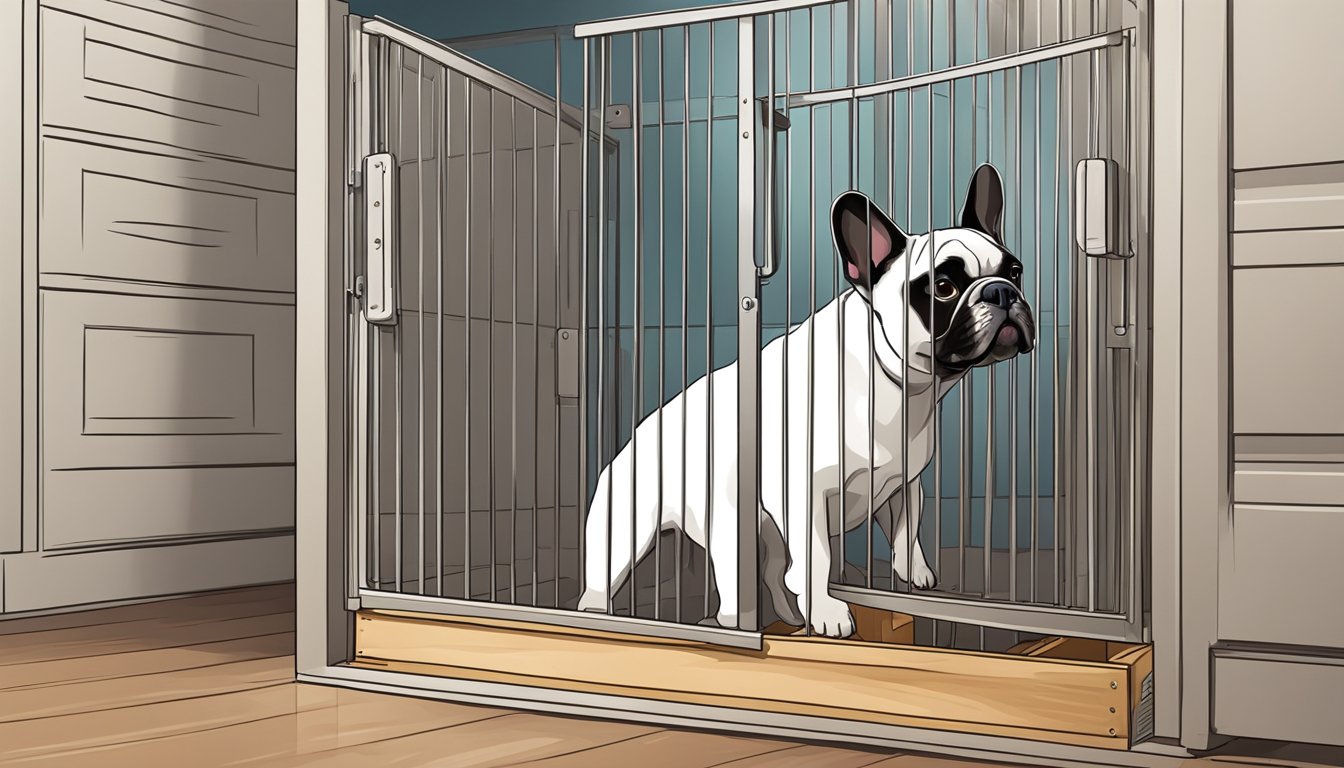
So, you’ve successfully crate trained your French Bulldog, and now it’s time to ease the transition from crate to house. What’s the best approach? Don’t worry, we’ve got your back. In this section, we’ll guide you through the process, focusing on housebreaking, bladder control, and potty training.
First, let’s talk about housebreaking. It’s important to establish a routine for your Frenchie. Consistency is key here. Start by taking your pup out for bathroom breaks at regular intervals throughout the day. Remember, French Bulldogs have a small bladder, so frequent breaks are a must.
To make the process smoother, try using a phrase like “go potty” whenever you take your dog outside for a bathroom break. This reinforces the connection between the phrase and their actions, helping them understand what you expect.
Now, let’s discuss potty training. A crucial aspect of this process is recognizing your Frenchie’s body language and signals. Be vigilant and learn to spot signs like sniffing, circling, or squatting – these are indicators that your pup needs to go. As soon as you notice these signs, calmly and quickly take them outside.
When your French Bulldog successfully does their business outside, praise and reward them with treats. Reinforcement is essential for reinforcing good behavior and motivating your pup to keep it up.
During this transition phase, accidents may happen inside the house. When they do, it’s essential to clean up the mess thoroughly, eliminating any lingering odors. Use an enzyme-based cleaner to make sure your dog doesn’t associate the spot with a bathroom area.
Lastly, be patient and persistent with your pup. Every dog has a unique learning curve, and it may take time for your French Bulldog to fully transition from crate to house. Keep up the consistent routine, pay attention to their signals, and provide encouragement and rewards for good behavior. In no time, your Frenchie will be confidently navigating their new domain.
The Role of Treats in Training
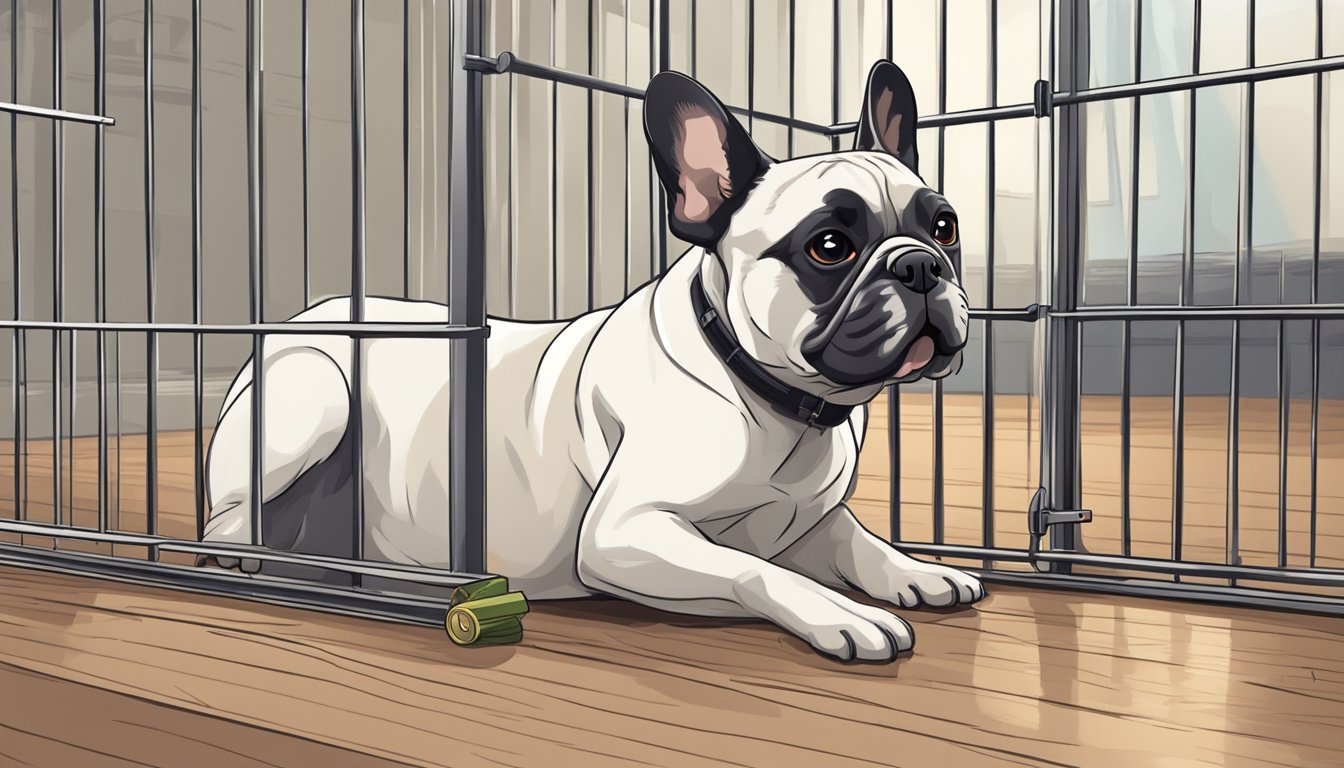
Are you wondering how to use treats effectively in your French Bulldog’s crate training? Well, you’ve reached the right spot! Treats play a crucial role in training, especially in creating positive experiences for your little furry friend.
When it comes to crate training your French Bulldog, think of treats as little tokens of encouragement. They serve as an instant reward for your pup’s good behavior, specifically when they follow your commands or exhibit progress in adapting to the crate. Treats can reinforce the desired behaviors, like staying calm and quiet inside the crate.
So, how can you effectively use treats for crate training? Start by choosing training treats that are small, soft, and easy for your French Bulldog to chew. Keep in mind, it’s essential to pick healthy options with low calories, as too many treats can lead to weight gain.
Once you’ve selected suitable treats, follow these guidelines:
- Introduce the crate – Place a treat inside the crate and encourage your French Bulldog to explore. This will create an association between the crate and a positive experience.
- Encourage calm behavior – Each time your dog stays calm inside the crate, reward them with a treat. This will reinforce their positive feelings towards the crate. Remember not to reward whining or excessive barking, as this might reinforce undesirable behaviors.
- Gradually increase crate time – As your pup becomes more comfortable inside the crate, slowly increase the time they spend inside, rewarding your dog at regular intervals.
- Add verbal cues – To facilitate your dog’s understanding, combine treats with verbal cues like “crate” or “bed.” Consistent cues and rewards will help your dog associate the crate with positive experiences and become more willing to go inside willingly.
Using treats effectively in your French Bulldog’s crate training journey will help create a comfortable and safe space for them. So, grab those delicious little rewards and begin your pup’s crate training adventure! Remember to always be patient, and celebrate your dog’s achievements with praise and love.
FAQs: French Bulldog Crate Training Guide
What size crate is best for a French Bulldog?
Choosing the right size crate for your French Bulldog is crucial for their comfort and safety. Generally, a crate size of 24 to 30 inches is suitable for a Frenchie. The crate should be large enough for your pup to stand up, turn around, and lie down comfortably. Remember, though, that not all dogs are the same size, so it’s always best to measure your dog to make sure you get the perfect fit.
How to potty train a French Bulldog puppy?
Potty training a French Bulldog puppy requires patience, consistency, and lots of positive reinforcement. Start by establishing a regular feeding schedule and take your pup outside to a designated spot after every meal. Use a keyword, like “potty” or “outside,” and praise them lavishly when they do their business. Gradually increase the time between bathroom breaks and always keep an eye out for signs they need to go, such as sniffing or circling. Remember, accidents happen – just stay patient and consistent!
How to help your French Bulldog sleep through the night?
To help your Frenchie sleep through the night, establish a consistent bedtime routine that includes a calm environment, a designated sleep area, and a regular sleep schedule. You can also tire your pup out by engaging in playtime or exercise a few hours before bedtime. If your French Bulldog is crate trained, make sure their crate is comfortable and inviting with a soft bed and their favorite toy.
Is it okay for a French Bulldog to sleep alone?
Yes, it is okay for a French Bulldog to sleep alone, as long as they have a safe and comfortable space to rest. This might include a crate, dog bed, or small room. However, Frenchies are known for being social animals and may prefer to sleep near their human companions. Make sure to closely observe your dog’s behavior and adjust their sleeping arrangements as needed to keep them happy and secure.
What if my French Bulldog refuses to sleep?
If your French Bulldog is refusing to sleep, there might be several reasons. It could be due to environmental factors like noise, light, or temperature, medical conditions, or anxiety. First, make sure the sleep environment is conducive to rest: quiet, dark, and a comfortable temperature. If your Frenchie is still struggling to sleep, consult with a veterinarian to rule out any medical issues or anxiety that might need treatment.
Should I have my French Bulldog sleep in a crate at night?
Having your Frenchie sleep in a crate at night can be beneficial for both you and your dog, as it provides a safe, cozy space for them. Crate training can also help with potty training, reduce anxiety and destructive behavior, and make traveling easier. If you decide to have your French Bulldog sleep in a crate, ensure it is the right size, well-ventilated, and comfortable with bedding, toys, and water.


